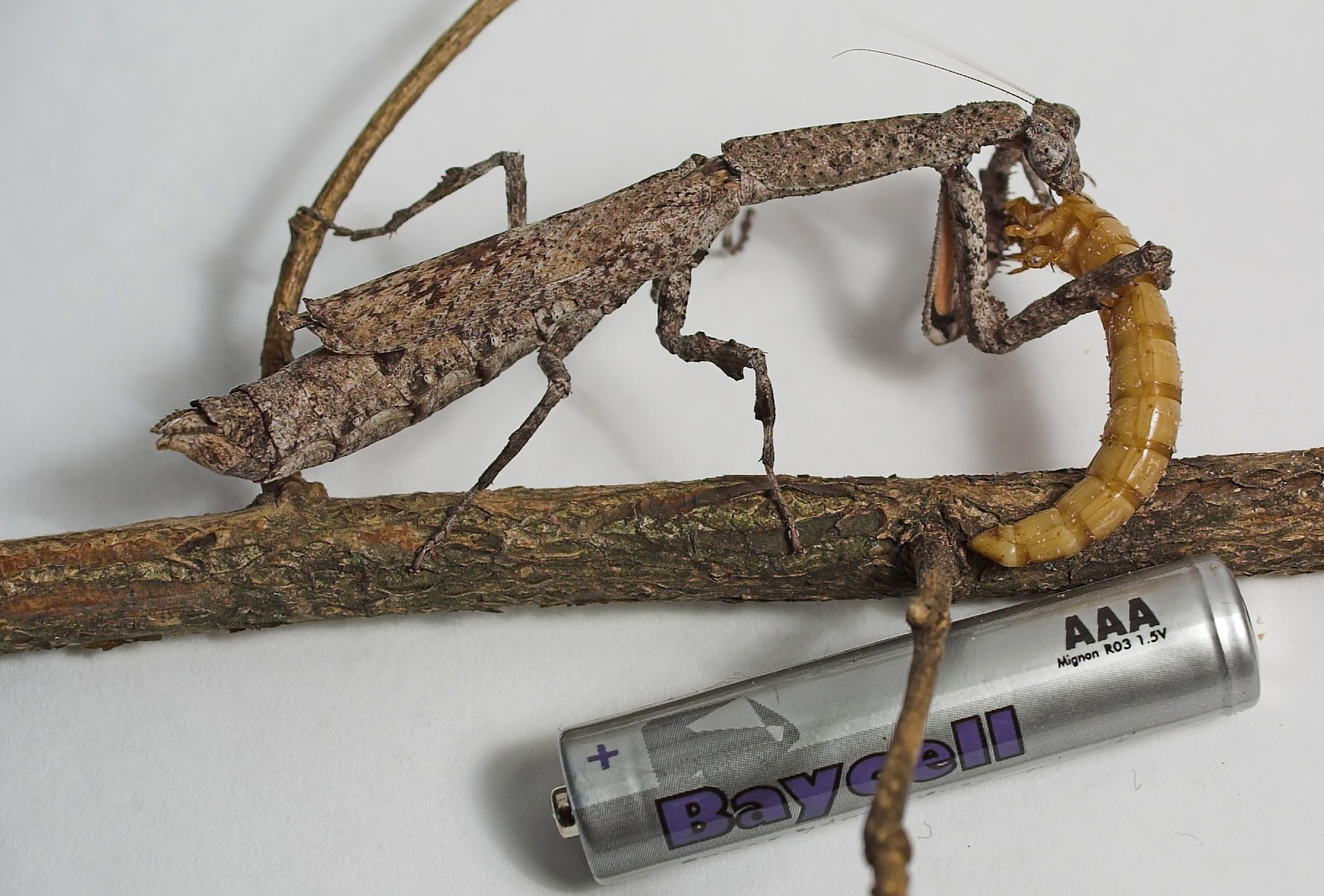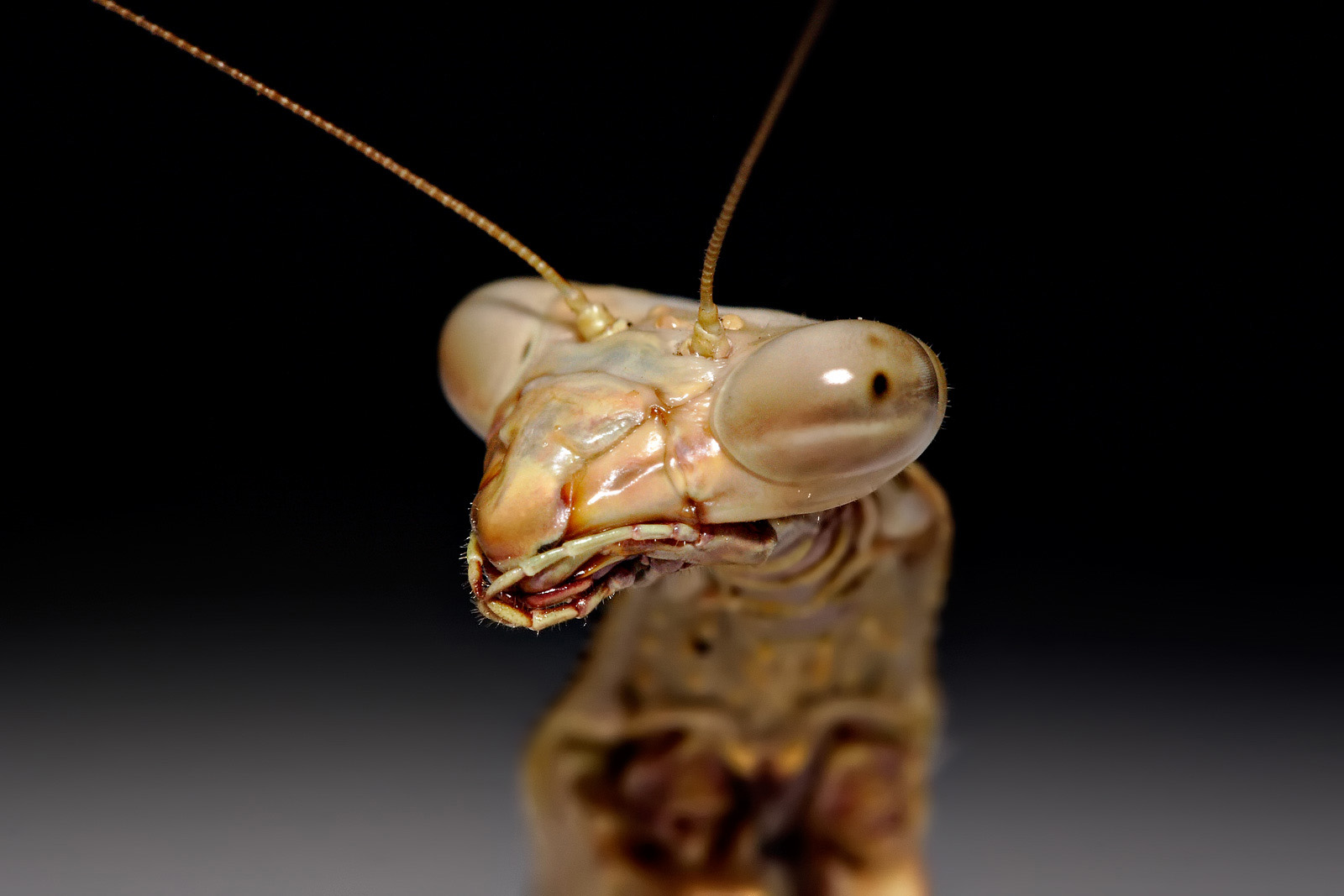|
Deroplatyidae
The ''Deroplatyidae'' are a new (2019) family of praying mantises, based on the type genus ''Deroplatys''. As part of a major revision of mantis taxonomy, the subfamily Deroplatyinae has been moved here from the previously-structured family Mantidae. The new placement is in superfamily Mantoidea (of group Cernomantodea) and infraorder Schizomantodea. Genera in this family have been recorded from: Africa, India, Indochina and Malesia. Subfamilies, tribes and genera The ''Mantodea Species File'' lists two subfamilies: Subfamily Deroplatyinae * tribe Deroplatyini (Asia) ** ''Deroplatys'' Westwood, 1839 ** '' Mythomantis'' Giglio-Tos, 1916 ** '' Pseudempusa'' Brunner v. W., 1893 * tribe Euchomenellini (Asia) ** '' Euchomenella'' Giglio-Tos, 1916 ** '' Indomenella'' Roy, 2008 ** '' Phasmomantella'' Vermeersch, 2018 ** '' Tagalomantis'' Hebard, 1920 Subfamily Popinae * tribe Leptocolini (Africa) ** subtribe Euchomenina *** '' Euchomena'' Saussure, 1870 ** subtribe Leptocol ... [...More Info...] [...Related Items...] OR: [Wikipedia] [Google] [Baidu] |
Popa (mantis)
''Popa''Serville (1839) ''Hist. Ins. Orth.'' 152. is an African genus of Mantodea, praying mantids in the subfamily Popinae and new (2019) family Deroplatyidae. Species The ''Mantodea Species File'' lists two species: * ''Popa gracilis'' Schulthess-Schindler, 1898 * ''Popa spurca'' Stal, 1856 References External links * * {{Taxonbar, from=Q10637486 Mantodea genera Deroplatyidae ... [...More Info...] [...Related Items...] OR: [Wikipedia] [Google] [Baidu] |
Deroplatyinae
Deroplatyinae is a subfamily in the new (2019) family Deroplatyidae, containing species found in South-East Asia. Tribes and selected genera The ''Mantodea Species File'' lists the following: * tribe Deroplatyini ** subtribe Deroplatyina *** ''Deroplatys'' Westwood, 1839 ** subtribe Pseudempusina *** '' Mythomantis'' Giglio-Tos, 1916 *** '' Pseudempusa'' Brunner v. W., 1893 * tribe Euchomenellini *** '' Euchomenella'' Giglio-Tos, 1916 *** '' Indomenella'' Roy, 2008 *** '' Phasmomantella'' Vermeersch, 2018 *** '' Tagalomantis'' Hebard, 1920 Note: the genus '' Brancsikia'' Saussure & Zehntner, 1895 is now placed in the family Majangidae. See also *List of mantis genera and species The following list of mantis genera and species is based on the "Mantodea Species File", which is the primary reference for the taxonomy shown here. The insect Order (biology), order Mantodea consists of over 2,400 species of mantises in about 460 ... References External linksTree of Life - Mant ... [...More Info...] [...Related Items...] OR: [Wikipedia] [Google] [Baidu] |
Deroplatys
''Deroplatys'' is a genus of mantis in the family Deroplatyidae. They are native to Asia and several share the common name of dead leaf mantis. Species The ''Mantodea Species File'' lists: * ''Deroplatys angustata'' (Westwood, 1845) * '' Deroplatys cordata'' (Fabricius, 1798) * ''Deroplatys desiccata'' (Westwood, 1839) - type species * ''Deroplatys gorochovi'' (Anisyutkin, 1998) * '' Deroplatys indica'' (Roy, 2007) * ''Deroplatys lobata'' (Guérin-Méneville (1838) * ''Deroplatys moultoni'' (Giglio-Tos, 1917) * '' Deroplatys philippinica'' (Werner, 1922) * ''Deroplatys rhombica'' (Brunner, 1897) * ''Deroplatys sarawaca'' (Westwood, 1889) * ''Deroplatys trigonodera'' (Westwood, 1889) * ''Deroplatys truncata'' (Guerin-Meneville, 1843) Captivity There are 4 ''Deroplatys'' species that are kept and bred in captivity (as exotic pets) and they are: *''Deroplatys lobata'' *''Deroplatys desiccata'' *''Deroplatys truncata'' *''Deroplatys trigonodera'' Additional images File:Deroplat ... [...More Info...] [...Related Items...] OR: [Wikipedia] [Google] [Baidu] |
Euchomenellini
Euchomenellini is a recently (2017) restored, southeast Asian tribe of mantises. It is now placed in the new (2019) family Deroplatyidae, genera having previously been placed in the Angelidae: which now consists only of neotropical mantises. Genera With the discovery of ''Phasmomantella'',Vermeersch XHC (2018) ''Phasmomantella'' gen. nov., a spectacular new genus of praying mantis from southern Central Vietnam (Mantodea, Mantidae, Deroplatyinae, Euchomenellini). ''European Journal of Taxonomy'' 442: 1–17. the following are included: * '' Euchomenella'' Giglio-Tos, 1916 (Vietnam, Borneo) * '' Indomenella'' Roy, 2008 (India) - monotypic ''I. indica'' (Ghate & Mukherjee, 2004) * '' Phasmomantella'' Vermeersch, 2018 (Vietnam Vietnam or Viet Nam ( vi, Việt Nam, ), officially the Socialist Republic of Vietnam,., group="n" is a country in Southeast Asia, at the eastern edge of mainland Southeast Asia, with an area of and population of 96 million, making i ...: 2 sp ... [...More Info...] [...Related Items...] OR: [Wikipedia] [Google] [Baidu] |
Danuria
''Danuria'' is a genus of African praying mantids in the family Deroplatyidae. Species *'' Danuria affinis'' *'' Danuria angusticollis'' *'' Danuria barbozae'' *'' Danuria buchholzi'' *'' Danuria congica'' *'' Danuria contorta'' *'' Danuria fusca'' *'' Danuria gracilis'' *'' Danuria impannosa'' *'' Danuria kilimandjarica'' *'' Danuria obscuripennis'' *'' Danuria serratodentata'' *'' Danuria sublineata'' *'' Danuria thunbergi'' See also *List of mantis genera and species The following list of mantis genera and species is based on the "Mantodea Species File", which is the primary reference for the taxonomy shown here. The insect Order (biology), order Mantodea consists of over 2,400 species of mantises in about 460 ... References Mantidae {{Mantidae-stub ... [...More Info...] [...Related Items...] OR: [Wikipedia] [Google] [Baidu] |
Popa Spurca Crassa Adult
Popa (''priest'' in Romanian) may refer to: People *Alina Popa (born 1978), Romanian-Swiss, IFBB professional bodybuilder * Anatolie Popa (1896–1920), Moldavian military commander *Celestina Popa (born 1970), Romanian, artistic gymnast *Constantin Popa (born 1971), Romanian-Israeli basketball player *Gabriel Popa (painter) (1937–1995), Romanian painter *Grigore T. Popa (1892–1948), Romanian physician * Ilie Popa (1907–1983), Romanian mathematician *Ion Popa (other), several people *Loredan Popa (born 1980), Romanian canoer *Marius Popa (born 1978), Romanian footballer *Mihnea Popa (born 1973), Romanian-American mathematician *Nicolae Popa (judge) (born 1939), Romanian judge *Nicolae Popa (businessman) (born c. 1965), a Romanian businessman *Roxana Popa (born 1997), a Romanian born Spanish artistic gymnast *Sorin Popa (born 1953), a Romanian-American mathematician *Toma Popa (1908–1962), Romanian chess master *Tudor Petrov-Popa (born 1963), Moldovan-Romanian politi ... [...More Info...] [...Related Items...] OR: [Wikipedia] [Google] [Baidu] |
Phasmomantella
''Phasmomantella''Vermeersch XHC (2018) ''Phasmomantella'' gen. nov., a spectacular new genus of praying mantis from southern Central Vietnam (Mantodea, Mantidae, Deroplatyinae, Euchomenellini). ''European Journal of Taxonomy'' 442: 1–17. is an genus of praying mantids placed in the tribe Euchomenellini and family Deroplatyidae. The two known species appear to be endemic to Vietnam. Species The ''Mantodea Species File'' lists: * '' Phasmomantella pallida'' (Roy, 2001) - reassigned from '' Euchomenella'' (Nha Trang, Vietnam) * '' Phasmomantella nuichuana'' Vermeersch, 2018 – type species (Núi Chúa National Park Núi Chúa National Park ( vi, Vườn quốc gia Núi Chúa, links=no), formerly Núi Chúa Nature Reserve is a national park in the province of Ninh Thuận Province, on the border with Khánh Hòa Province, South Central Coast, Vietnam. F ..., Vietnam) References External links * {{taxonbar, from=Q67000529 Mantodea genera Insects of Southeas ... [...More Info...] [...Related Items...] OR: [Wikipedia] [Google] [Baidu] |
Mantodea Families
Mantises are an order (Mantodea) of insects that contains over 2,400 species in about 460 genera in 33 families. The largest family is the Mantidae ("mantids"). Mantises are distributed worldwide in temperate and tropical habitats. They have triangular heads with bulging eyes supported on flexible necks. Their elongated bodies may or may not have wings, but all Mantodea have forelegs that are greatly enlarged and adapted for catching and gripping prey; their upright posture, while remaining stationary with forearms folded, has led to the common name praying mantis. The closest relatives of mantises are termites and cockroaches (Blattodea), which are all within the superorder Dictyoptera. Mantises are sometimes confused with stick insects (Phasmatodea), other elongated insects such as grasshoppers (Orthoptera), or other more distantly related insects with raptorial forelegs such as mantisflies (Mantispidae). Mantises are mostly ambush predators, but a few ground-dwelling spe ... [...More Info...] [...Related Items...] OR: [Wikipedia] [Google] [Baidu] |
Mantodea
Mantises are an order (Mantodea) of insects that contains over 2,400 species in about 460 genera in 33 families. The largest family is the Mantidae ("mantids"). Mantises are distributed worldwide in temperate and tropical habitats. They have triangular heads with bulging eyes supported on flexible necks. Their elongated bodies may or may not have wings, but all Mantodea have forelegs that are greatly enlarged and adapted for catching and gripping prey; their upright posture, while remaining stationary with forearms folded, has led to the common name praying mantis. The closest relatives of mantises are termites and cockroaches (Blattodea), which are all within the superorder Dictyoptera. Mantises are sometimes confused with stick insects (Phasmatodea), other elongated insects such as grasshoppers (Orthoptera), or other more distantly related insects with raptorial forelegs such as mantisflies (Mantispidae). Mantises are mostly ambush predators, but a few ground-dwelling spe ... [...More Info...] [...Related Items...] OR: [Wikipedia] [Google] [Baidu] |
Schizomantodea
Mantises are an order (Mantodea) of insects that contains over 2,400 species in about 460 genera in 33 families. The largest family is the Mantidae ("mantids"). Mantises are distributed worldwide in temperate and tropical habitats. They have triangular heads with bulging eyes supported on flexible necks. Their elongated bodies may or may not have wings, but all Mantodea have forelegs that are greatly enlarged and adapted for catching and gripping prey; their upright posture, while remaining stationary with forearms folded, has led to the common name praying mantis. The closest relatives of mantises are termites and cockroaches (Blattodea), which are all within the superorder Dictyoptera. Mantises are sometimes confused with stick insects ( Phasmatodea), other elongated insects such as grasshoppers ( Orthoptera), or other more distantly related insects with raptorial forelegs such as mantisflies (Mantispidae). Mantises are mostly ambush predators, but a few ground-dwelling ... [...More Info...] [...Related Items...] OR: [Wikipedia] [Google] [Baidu] |
Malesia
Malesia is a biogeographical region straddling the Equator and the boundaries of the Indomalayan and Australasian realms, and also a phytogeographical floristic region in the Paleotropical Kingdom. It has been given different definitions. The World Geographical Scheme for Recording Plant Distributions split off Papuasia in its 2001 version. Floristic province Malesia was first identified as a floristic region that included the Malay Peninsula, the Malay Archipelago, New Guinea, and the Bismarck Archipelago, based on a shared tropical flora derived mostly from Asia but also with numerous elements of the Antarctic flora, including many species in the southern conifer families Podocarpaceae and Araucariaceae. The floristic region overlaps four distinct mammalian faunal regions. The first edition of the World Geographical Scheme for Recording Plant Distributions (WGSRPD) used this definition, but in the second edition of 2001, New Guinea and the Bismarck Archipelago were r ... [...More Info...] [...Related Items...] OR: [Wikipedia] [Google] [Baidu] |



